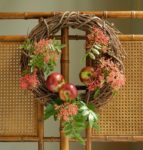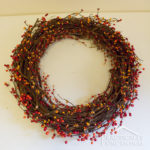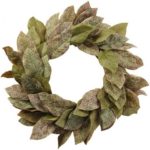Grapevine Wreath
Gardening Gloves
Pruning Shears
4-5 lengths of grapevine, each about 6-12 feet long
Natural Decorations, such as dried flowers, pinecones, sprigs of berries, or pieces of evergreen
Other decorations such as bits of ribbon, artificial birds, etc.
Wire Cutters
Paddle Wire
The important thing to remember when gathering outdoor materials is to be a responsible collector. A responsible collector remembers to do the following:
• Look for dead or fallen materials first. Pine needles, dried leaves, empty shells, and rocks are not alive. You are not disturbing nature too much if you remove small amounts of these materials.
• Check with an adult before picking anything from a living plant. You don’t want to pick something poisonous. Also you need to make sure you are not picking from a plant that may be endangered.
• Many plants benefit from a careful pruning. Never destroy an entire plant. Choose your materials carefully.
• Never take materials from someone else’s property without asking.
• Watch out for animals. You should never disturb a wasp’s nest. Don’t take eggs from a bird’s nest. Never cover the hole of an underground burrow. Be careful when lifting debris such a large branches or rocks as they may be homes for insects or small rodents or snakes.
• Disturb nature as little as possible. Leave an area as close to possible as the way you found it. Leave no trace!
The main ingredient of a wreath is, of course, the vine itself, and the best time to forage for grapevines is during their dormant season . . . which in most places falls between September and April. And, if you don’t have an arbor or access to a vine-draped woods, a friend or neighbor who grows grapes would doubtless be glad to exchange some vines for a little pruning assistance.
Once you’ve located a harvestable crop of vines, collecting them is a snap! Just pull on your gloves and use a sharp pair of shears to cut them, and then pull them free. Be careful not to fall backwards; it may feel like a tug of war game! If any dried leaves or fruit are still on the branches, try to remove them as you snatch the canes out being careful to leave as many of the delicately curling tendrils as possible, since it’s these tiny “locklets” that’ll give your wreath its distinction.
Instead of trying to transport the sprawling mass home, a lot of folks turn the vines into wreaths right where they collect them. However, if you’d rather work in the comfort of your own yard, lay the vines on the ground in manageable bunches as you collect them. Then, when you’re through pruning, loosely wrap each bundle — one at a time — around your forearm from your hand to your elbow . . .and tie the pieces together into a portable circle with twine, string, or light wire. This may your harvest lot easier to stack and haul.
Hold the end of the longest vine in one hand. Then loop the vine into a circle shape. This can be as large or as small as you wish. An 18†to 20†circle is a good workable size. Next weave the other end of the vine in and out around the circle. Twist is around as if you were wrapping a ribbon around a candy cane. Continue weaving until you reach the end of the vine. Tuck the end of the vine into the wreath. Tuck the next vine into the wreath and weave it in and out around the wreath as you did with the first. Continue to add vines and weave until the wreath reaches your desired thickness. Let your wreath sit a few days to dry out.
Once the wreath is dry, decorate it with your natural items by tucking them into the spaces between the vines. Add your ribbons and other decorations as desired. Cut a 12-inch length of paddle wire and thread it through the top of the wreath. Twist the ends together to create a loop for hanging.
Similar wreaths can be made from kudzu, bittersweet, wisteria, at honeysuckle vines. While you’re out foraging, you might get some of them to experiment with . . . but take care not to gather poison ivy!

















